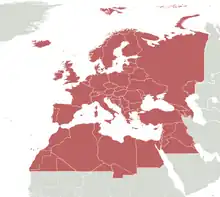Agreement on the Conservation of Populations of European Bats
The Agreement on the Conservation of Populations of European Bats, or EUROBATS, is an international treaty that binds its States Parties on the conservation of bats in their territories. It was signed in 1991 under the auspices of the Convention on the Conservation of Migratory Species of Wild Animals (CMS), with the Agreement entering into force in 1994. In August 2021, the Agreement applied to 38 of 63 range states.
| Agreement on the Conservation of Populations of European Bats | |
|---|---|
 | |
| Type | Multilateral |
| Context | Bat conservation |
| Signed | 4 December 1991 |
| Location | London, United Kingdom |
| Effective | 16 January 1994 |
| Condition | Ratification by five range states |
| Parties | List
|
| Depositary | Government of the United Kingdom |
| Languages | |
| Full text | |
History
The Agreement was concluded as "Agreement on the Conservation of Bats in Europe" in September 1991 during the Third Meeting of the Parties of the Convention on Migratory Species. It entered into force on 16 January 1994, after the required number of five states (Germany, The Netherlands, Norway, Sweden and UK) had ratified it.
In 2000, the Parties decided to change the Agreement's name into its current form "Agreement on the Conservation of Populations of European Bats". In 2001, the Agreement became part of the United Nations Environment Programme (UNEP).
Aim of the agreement
The overall goal of the Agreement is to provide a framework for bat conservation for the member states and those that have not yet joined. According to the agreement text, member states prohibit the deliberate capture, keeping or killing of bats except for research purposes for which a special permit is required. Furthermore, the member states identify important sites for bat conservation, survey the status and trends of bat populations and study their migratory patterns. Based on the result of these monitoring activities the Agreement develops and reviews recommendations and guidelines that shall be implemented by the Parties on national levels.
Bodies of the agreement
Meeting of the parties
The Meeting of the parties is the highest decision-making body of the Agreement and adopts Resolutions. Every Party has one vote. Non-Party range states as well as bat conservation organisations may be represented as observers at the meetings.
The Meeting of the Parties takes place at changing locations every three to four years, most recently in Prague, Czech Republic, 20 – 22 September 2010. (Status: October 2012)
Advisory committee
The advisory committee is the working body of the agreement. It evaluates data and discusses scientific issues concerning bat research and conservation to set priorities for the Agreement' future work. The committee deals with topics like bat migration, light pollution or the impact of wind turbines on bat populations. Furthermore, it drafts the Resolutions to be adopted at the Meetings of the Parties.
The Committee meets once a year, most recently in Dublin, Ireland, 15–17 May 2012. (Status: October 2012)
Standing committee
The standing committee is the administrative body of the Agreement. It monitors the execution of the Secretariat's budget, oversees the implementation of policies by the Secretariat and discusses further administrative matters like staff issues. The committee was established by the 5th Meeting of the Parties in autumn 2006 to redesign the Advisory Committee to scientific issues.
The Committee shall meet once a year, if a meeting is needed, at the UN Campus in Bonn/Germany. The first Meeting took place in March 2007, the most recent one in Paris, France, on 28 March 2012. (Status: October 2012)
Secretariat
The Secretariat is the executive body of the Agreement. It coordinates and organises the activities of the Meeting of the Parties, the Advisory Committee and the Standing Committee and undertakes initiatives for implementing the aspired aims, attracting more member states and exchanging information. Furthermore, it coordinates international research and monitoring activities.
Another main task of the Secretariat is to raise public awareness. The “European Bat Night” goes back to an initiative of the EUROBATS Secretariat and is today an event in more than 30 European states.
The Secretariat was established by the 1st Meeting of the Parties in 1995 and started its work in Bonn/Germany in 1996. Since June 2006 it is accommodated at the UN Campus in the former parliamentary building of the Federal Republic of Germany.
Agreement area

When it was signed in 1991, the agreement defined the area of the agreement as "the continent of Europe."[1] This ambiguity led to some confusion, and multiple resolutions were passed to try to clarify this matter. A resolution of the 2nd Session of the Meeting of Parties in 1998 defined the area as follows: the Western Palaearctic region, excluding North Africa, Iceland and many of Middle Eastern states in its definition. This definition was reaffirmed in 2006.[2][3]
However, at the 6th Session of the Meeting of Parties in 2010, Resolution 6.3 defined the scope of the agreement as the Western Palaearctic region. More specifically, it stated that its boundaries were as follow:[4]
- To the North, the Svalbard Archipelago
- To the East, longitude 50° E
- To the South, the countries of the Mediterranean Basin
- To the West, the Azores at 30° West
This new definition recognized that European bats were migrating to and from beyond the previously designated geographical scope of the Agreement as defined in 1998. This new definition included countries in the Middle East and North Africa, the islands owned by European states in the Mediterranean as well as some Central Asian states.[4]
Species
EUROBATS currently lists 51 species of bat that occur naturally in Europe that the Agreement pertains to. They are as follow:[5]
- Emballonuridae
- Molossidae
- Pteropodidae
- Rhinolophidae
- Vespertilionidae
- Vespertilionidae (cont.)
- Eptesicus serotinus
- Hypsugo savii
- Myotis alcathoe
- Myotis bechsteinii
- Myotis blythii
- Myotis brandtii
- Myotis capaccinii
- Myotis dasycneme
- Myotis daubentonii
- Myotis davidii
- Myotis emarginatus
- Myotis escalerai
- Myotis myotis
- Myotis mystacinus
- Myotis nattereri
- Myotis punicus
- Myotis schaubi
- Nyctalus azoreum
- Vespertilionidae (cont.)
- Nyctalus lasiopterus
- Nyctalus leisleri
- Nyctalus noctula
- Otonycteris hemprichii
- Pipistrellus hanaki
- Pipistrellus kuhlii
- Pipistrellus maderensis
- Pipistrellus nathusii
- Pipistrellus pipistrellus
- Pipistrellus pygmaeus
- Plecotus auritus
- Plecotus austriacus
- Plecotus kolombatovici
- Plecotus macrobullaris
- Plecotus sardus
- Plecotus teneriffae
- Vespertilio murinus
- Miniopterus pallidus
- Miniopterus schreibersii
Pertaining states
States parties
The following are all the states that have ratified the Agreement, and are regarded as its member states:[6]
| Country | Date of signing | Date of deposit of instrument of ratification |
|---|---|---|
| 22 June 2001 | ||
| 4 December 1991 | 14 May 2003 | |
| 22 July 2021 | ||
| 9 November 1999 | ||
| 8 August 2000 | ||
| 13 November 2012 | ||
| 24 February 1994 | ||
| 4 December 1991 | 6 January 1994 | |
| 11 November 2004 | ||
| 20 September 1999 | ||
| 10 December 1993 | 7 July 1995 | |
| 25 July 2002 | ||
| 5 December 1991 | 18 October 1993 | |
| 22 June 1994 | ||
| 21 June 1993 | 21 June 1995 | |
| 20 October 2005 | ||
| 15 December 2014 | ||
| 1 August 2003 | ||
| 28 November 2001 | ||
| 4 December 1991 | 29 October 1993 | |
| 2 March 2001 | ||
| 2 February 2001 | ||
| 23 July 1999 | ||
| 28 March 2011 | ||
| 4 December 1991 | 17 March 1992 | |
| 15 September 1999 | ||
| 3 February 1993 | Not necessary | |
| 10 April 1996 | ||
| 4 June 1993 | 10 January 1996 | |
| 20 July 2000 | ||
| 9 April 2009 | ||
| 8 February 2019 | ||
| 9 July 1998 | ||
| 5 December 2003 | ||
| 4 March 1992 | Not necessary | |
| 27 July 2013 | ||
| 30 September 1999 | ||
| 4 December 1991 | 9 September 1992 |
Range states
The following are all of the states that have territory within the range of the Agreement, but have yet to sign or ratify it:[6]
References
- "Agreement on the Conservation of Bats in Europe" (PDF). Eurobats. United Nations Environment Programme/Eurobats. 4 December 1991. Retrieved 7 August 2019.
- "2nd Session of the Meeting of Parties: Resolution 2.5 – Geographical Scope of the Agreement" (PDF). Eurobats. United Nations Environment Programme/Eurobats. July 1998. Retrieved 7 August 2019.
- "5th Session of the Meeting of Parties: Resolution 5.11 – Geographical Scope of the Agreement" (PDF). Eurobats. United Nations Environment Programme/Eurobats. September 2006. Retrieved 7 August 2019.
- "6th Session of the Meeting of Parties: Resolution 6.3 – Geographical Scope of the Agreement" (PDF). Eurobats. United Nations Environment Programme/Eurobats. September 2010. Retrieved 7 August 2019.
- "8th Session of the Meeting of the Parties: Resolution 8.2 – Amendment of the Annex to the Agreement" (PDF). Eurobats. United Nations Environment Programme/Eurobats. October 2018. Retrieved 7 August 2019.
- "Agreement on the Conservation of Populations of European Bats" (PDF). Eurobats. United Nations Environment Programme/Eurobats. May 2019. Retrieved 7 August 2019.